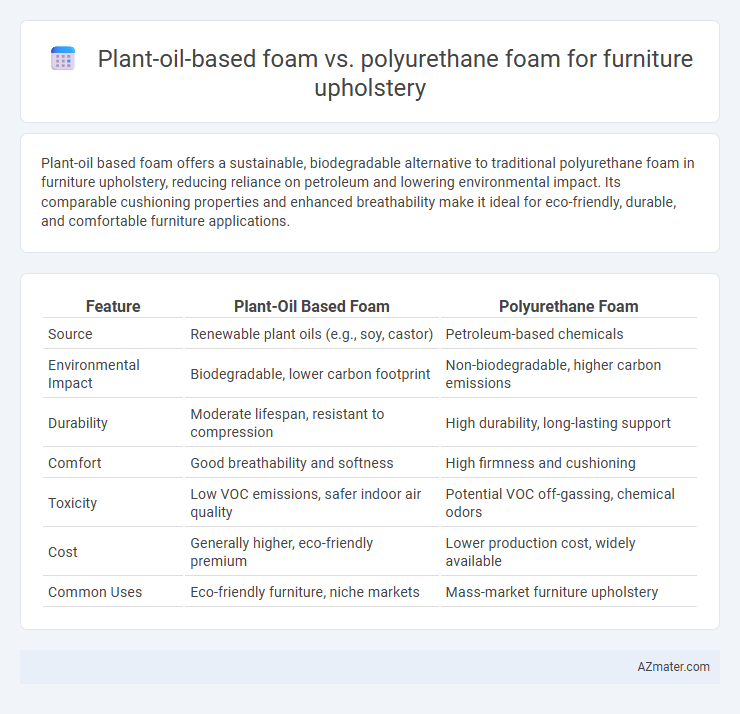Plant-oil based foam offers a sustainable, biodegradable alternative to traditional polyurethane foam in furniture upholstery, reducing reliance on petroleum and lowering environmental impact. Its comparable cushioning properties and enhanced breathability make it ideal for eco-friendly, durable, and comfortable furniture applications.
Table of Comparison
| Feature | Plant-Oil Based Foam | Polyurethane Foam |
|---|---|---|
| Source | Renewable plant oils (e.g., soy, castor) | Petroleum-based chemicals |
| Environmental Impact | Biodegradable, lower carbon footprint | Non-biodegradable, higher carbon emissions |
| Durability | Moderate lifespan, resistant to compression | High durability, long-lasting support |
| Comfort | Good breathability and softness | High firmness and cushioning |
| Toxicity | Low VOC emissions, safer indoor air quality | Potential VOC off-gassing, chemical odors |
| Cost | Generally higher, eco-friendly premium | Lower production cost, widely available |
| Common Uses | Eco-friendly furniture, niche markets | Mass-market furniture upholstery |
Introduction to Upholstery Foam Materials
Plant-oil based foam, derived from renewable resources like soy or castor oil, offers an eco-friendly alternative to traditional polyurethane foam commonly used in furniture upholstery. While polyurethane foam provides durable cushioning with high resilience and support, plant-oil based foams reduce reliance on petroleum and lower carbon emissions, contributing to sustainable manufacturing practices. Advances in bio-based foam technology enable comparable comfort, longevity, and flame retardancy levels, making plant-oil alternatives increasingly viable for modern upholstery applications.
What is Plant-Oil Based Foam?
Plant-oil based foam is a sustainable alternative to traditional polyurethane foam, derived from renewable plant oils such as soy, castor, or palm oil. This foam offers comparable durability, comfort, and resilience, making it suitable for furniture upholstery while reducing reliance on fossil fuels. Its biodegradable properties and lower environmental footprint contribute to eco-friendly and health-conscious upholstery solutions.
Understanding Polyurethane Foam
Polyurethane foam, widely used in furniture upholstery, is a versatile synthetic material made from petrochemical derivatives offering excellent durability, cushioning, and resistance to wear. Its cellular structure provides consistent support and flexibility, making it a preferred choice for high-traffic furniture applications. Advances in formulation have improved its flame retardancy and density options, but environmental concerns have driven interest in sustainable alternatives like plant-oil based foams.
Environmental Impact: Plant-Oil vs. Polyurethane Foam
Plant-oil based foam offers a lower environmental impact due to its renewable resources, reduced carbon footprint, and increased biodegradability compared to conventional polyurethane foam. Polyurethane foam, derived from petrochemicals, contributes to higher greenhouse gas emissions and persistence in landfills, causing long-term pollution concerns. Choosing plant-oil based foam supports sustainable furniture production by minimizing dependence on fossil fuels and promoting eco-friendly disposal.
Comfort and Performance Comparison
Plant-oil based foams offer superior breathability and moisture resistance compared to traditional polyurethane foams, enhancing comfort by regulating temperature and reducing sweat buildup during extended use. These bio-based foams demonstrate comparable resilience and compression set values, ensuring long-lasting support and shape retention in furniture upholstery. Polyurethane foam, while widely used for its high density and durability, may off-gas volatile organic compounds (VOCs), whereas plant-oil foams provide an eco-friendly alternative with low VOC emissions, contributing to healthier indoor air quality.
Durability and Lifespan of Both Foams
Plant-oil based foam offers comparable durability and longer lifespan due to its enhanced resistance to compression set and environmental degradation compared to traditional polyurethane foam. Polyurethane foam tends to degrade faster, losing resilience and support over time, which can reduce furniture longevity. The natural oils in plant-based foam contribute to its structural integrity, making it a sustainable alternative with improved durability for upholstery applications.
Health and Safety Considerations
Plant-oil based foam for furniture upholstery offers significant health benefits by minimizing exposure to volatile organic compounds (VOCs) and toxic chemicals commonly found in polyurethane foam, promoting better indoor air quality. Unlike polyurethane foam, which can off-gas harmful substances such as isocyanates and flame retardants potentially irritating respiratory systems, plant-oil foams are formulated with natural, biodegradable materials that reduce allergenic reactions and chemical sensitivities. Choosing plant-oil based foam supports safer living environments by aligning with green building standards and reducing the risk of long-term health issues associated with synthetic foam emissions.
Cost Analysis and Market Availability
Plant-oil based foam for furniture upholstery offers a competitive cost advantage due to renewable raw materials and reduced reliance on petroleum, but its price can be slightly higher than conventional polyurethane foam depending on scale and demand. Polyurethane foam remains more widely available in the market, benefiting from established manufacturing infrastructure and consistent supply chains that drive lower overall production costs. Market trends indicate increasing investment in plant-oil foam production to improve economies of scale, signaling potential future cost parity and expanded availability.
Consumer Preferences and Trends
Plant-oil based foam is gaining consumer preference due to its eco-friendly properties and biodegradable nature, appealing to environmentally conscious buyers. Polyurethane foam remains popular for its superior durability, comfort, and cost-effectiveness in furniture upholstery. Trends show a growing demand for sustainable materials, driving manufacturers to incorporate plant-oil based foam while maintaining performance standards similar to traditional polyurethane foam.
Conclusion: Choosing the Right Foam for Upholstery
Plant-oil based foam offers a sustainable, eco-friendly alternative to traditional polyurethane foam, with superior breathability and reduced off-gassing, making it ideal for environmentally conscious consumers. Polyurethane foam remains cost-effective and provides excellent durability and support for high-traffic furniture use. Selecting the right foam depends on balancing factors like environmental impact, comfort preferences, and budget constraints in upholstery projects.

Infographic: Plant-oil based foam vs Polyurethane foam for Furniture upholstery
 azmater.com
azmater.com